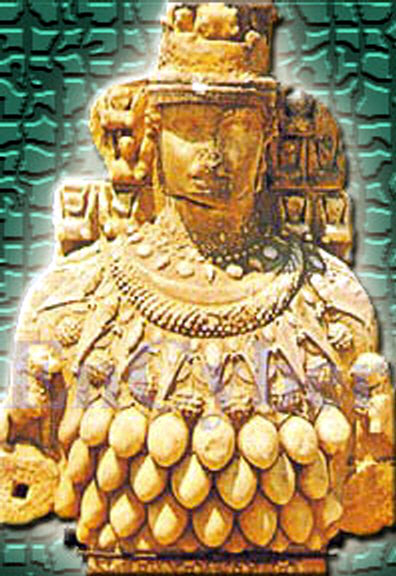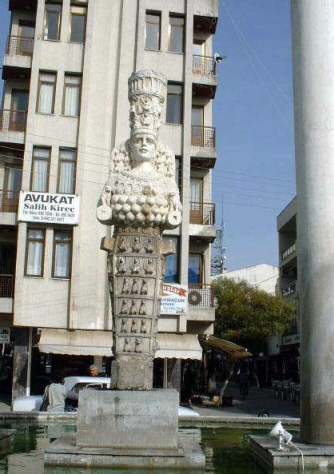|
The Lady of Ephesus, 1st century AD, Ephesus Archaeological Museum
(출처- http://en.wikipedia.org/wiki/File:Artemis_Efes_Museum.JPG)
아데미 여신(The Artemis of Ephesus)은 아나톨리아에서 가장 신성시 하였던 신으로 처음에는 킬벨레 (Kylbele)라 불리웠다. 이 여신은 광범위하게 영향을 끼쳐 로마와 메소포타미아 및 아라비아에서도 섬기었다. 아랍인은 '라트'로, 이집트인은 '이시스'로, 그리스인은 아르테미스(사냥의 여신), 로마인은 '디아나'로 불렀으며 이오니아인들이 '아데미'라 불렀다. 처음 킬벨레로 불리울 때는 목신 상이었으며 서부 아나톨리아에서 이오니아 문명과 함께 아데미로 이름이 바뀌었고 땅과 다산을 상징하였다. 에베소 사람들이 열정적으로 숭배했던 아데미 여신은 가슴에 유방이 24개가 달린 풍요의 여신이다. 아데미 여신의 머리에는 바벨론을 상징하는 성이 있고, 몸에는 특이한 사냥꾼 니므롯을 상징하는 사자, 호랑이, 사슴 등의 다양한 짐승들의 부조로 새겨져 있다. 매년 5월 아데미 여신의 축제날이 되면 유방과 같은 수의 24명의 흰 옷을 입은 여자 사제들이 앞에 서고, 뒤에는 자신의 고환을 아데미 여신에게 바친 남자 사제들이 여신의 호위병처럼 뒤 따른다. 제의 행렬은 아데미 신전에서부터 시작된다. 아데미 신전에서 출발한 아데미 신상과 축제 행렬은 에베소 시의 동쪽에 있는 마그네시아 문을 통해 입성하고, 동방 체육관과 시장, 음악당을 지나서 에베소 시청에 이른다. 에베소 시청 앞에는 또 하나의 아데미 여신상이 밖을 향하여 서 있는데 두 개의 여신상이 만나게 되면 군중들의 열광은 절정에 이르게 된다. 이때, 에베소의 총독은 관저에서 나와서 아데미 여신에게 경의를 표하게 된다. 총독의 인사를 받은 아데미 여신상은 크레테 도로를 지나 셀수스 도서관을 거쳐 에베소 광장에 이른다. 광장에서 왼쪽 방향으로 항구대로를 지나 부두에 이르게 된다. 부두에 이르면, 드디어 소들을 바치는 희생 제사가 드려진다. 남자 사제들이 24마리의 황소 고환을 잘라 아데미 여신의 목에 걸어 주면, 군중들이 함성을 터뜨리기 시작한다. 무용수들은 음악에 따라 춤을 추고, 도살된 소들이 제단에 올려지면, 이때부터 본격적으로 아데미 축제가 무르익게 된다.
Artemis of Ephesus. 1st century CE Roman copy of the cult statue of the Temple of Ephesus. Statue in the Museum of Efes (출처-http://commons.wikimedia.org/wiki/File:Artemis_Ephesos.JPG )
Artemis of Ephesus. Terracotta figurine of Smyrna, 1st century BC (출처- http://commons.wikimedia.org/wiki/File:Artemis_Ephesia_Louvre_CA1202.jpg)
Artemis of Ephesus. 1st century BC. Currently on display in Room 31 of the National Archaeological Museum in Athens. (출처-http://commons.wikimedia.org/wiki/File:1473_-_Archaeological_Museum,_Athens_-_Ephesian_Artemis)
Artemis of Ephesus. 1st century CE Roman copy of the cult statue of the Temple of Ephesus. Statue in the Museum of Efes (출처- http://commons.wikimedia.org/wiki/File:046.pos%C4%85g_Artemidy.JPG)
Artemis of Ephesus (출처-http://0.tqn.com/d/ancienthistory/1/0/V/L/3/Ephesian_Artemis.jpg )
얼굴 양옆에 사자, 소 등의 모습이 있다. 풍요(다산)를 상징하는 동물이다. 아데미 여신 가슴부분의 동그란 것은 여신에게 바친 소의 고환을 나타냈다. 이 역시 풍요를 상징한다.
Artemide Efesia risalente al II secolo d.C. La statua rappresenta l'immagine cultuale presente nel tempio di Artemide a Efeso, Museo archeologico nazionale di Napoli. (출처-http://commons.wikimedia.org/wiki/File:Artemide_Efesia.jpg)
Artemide Efesia risalente al II secolo d.C. La statua rappresenta l'immagine cultuale presente nel tempio di Artemide a Efeso, Museo archeologico nazionale di Napoli. (출처-http://commons.wikimedia.org/wiki/File:Artemide_Efesia.jpg)
Giorgio Sommer (1834-1914) - "Artemis of Ephesus. Museum of Naples", Italy. Catalogue # 5439.
Roman copy of the Ephesian Artemis and marble sarcophagus decorated with a bas-relief depicting "The myth of Orestes". - Galleria dei Candelabri (Vatican Museums). (출처-http://commons.wikimedia.org/wiki/File:0_Artemis_d%27Eph%C3%A8se_-_Sarcophage_du_Myhthe_d%27Oreste_-_Vatican_ )
아데미 여신, 바티칸박물관
Roman copy of the Ephesian Artemis and marble sarcophagus decorated with a bas-relief depicting "The myth of Orestes". - Galleria dei Candelabri (Vatican Museums). (출처-http://commons.wikimedia.org/wiki/File:0_Artemis_d%27Eph%C3%A8se_-_Sarcophage_du_Myhthe_d%27Oreste_-_Vatican_ )
Roman copy of the Ephesian Artemis and marble sarcophagus decorated with a bas-relief depicting "The myth of Orestes". - Galleria dei Candelabri (Vatican Museums). (출처-http://commons.wikimedia.org/wiki/File:0_Artemis_d%27Eph%C3%A8se_-_Sarcophage_du_Myhthe_d%27Oreste_-_Vatican_ )
Artemis of Ephesus. Marble and bronze, Roman copy of an Hellenistic original of the 2nd century BC. Musei Capitolini (출처- http://commons.wikimedia.org/wiki/File:0_Artemis_of_Ephesus_-_Musei_Capitolini_(1).JPG)
Artemis of Ephesus. Marble and bronze, Roman copy of an Hellenistic original of the 2nd century BC. Musei Capitolini (출처- http://commons.wikimedia.org/wiki/File:0_Artemis_of_Ephesus_-_Musei_Capitolini_(1).JPG)
Museo civico archeologico (Bologna) (출처-http://commons.wikimedia.org/wiki/File:Statuetta_di_artemide_efesina_01.JPG )
Museo civico archeologico (Bologna) (출처-http://commons.wikimedia.org/wiki/File:Statuetta_di_artemide_efesina_02.JPG)
Statuette of the Ephesian Artemis, 2nd century AD, Villa of the Quintili, Via Appia, Rome (출처-http://commons.wikimedia.org/wiki/File:Statuette_of_the_Ephesian_Artemis,_2nd_century_AD,_Villa_of_the_Quintili,_Via_Appia,)
Terminal Figure - Diana of Ephesus (출처-http://commons.wikimedia.org/wiki/File:Terminal_Figure_-_Diana_of_Ephesus.jpeg)
Troso di artemis di efeso, (출처-http://commons.wikimedia.org/wiki/File:Troso_di_artemis_di_efeso,_IV_sec._dc..JPG)
Artemis of Ephesus (출처- http://commons.wikimedia.org/wiki/File:Artemis_of_Ephesus_2.jpg)
The Godess Nature Fountain in the garden of Villa d'Este in Tivol, Italy (출처-http://commons.wikimedia.org/wiki/File:The_Godess_Nature_Fountain.jpg )
Traditional many-breasted interpretation in a 16th-century fountain of Diana Efesina, Villa d'Este (출처- http://en.wikipedia.org/wiki/File:Fontana_di_Diana_Efesina-Tivoli,_Villa_d%27Este.jpg)
The Godess Nature Fountain in the garden of Villa d'Este in Tivol, Italy (출처-http://commons.wikimedia.org/wiki/File:The_Godess_Nature_Fountain.jpg )
Grabstein auf dem Assistens Kirkeg?rd in Kopenhagen (출처-http://commons.wikimedia.org/wiki/File:Peter_Christian_Abildgaard_02.jpg )
Giulio Aristide Sartorio Diana of Ephesus and the slaves (출처-http://commons.wikimedia.org/wiki/File:Giulio_Aristide_Sartorio_Diana_of_Ephesus_and_the_slaves.jpg )
Daniel Chodowiecki: Ex Libris f?r seine eigene Bibliothek. Kupferstich. (출처-http://commons.wikimedia.org/wiki/File:Chodowiecki_Ex_Libris.jpg ) Medaglione di commodo, zecca di efeso e pergamo, asclepio e statua di artemide efesina (출처-http://commons.wikimedia.org/wiki/File:Medaglione_di_commodo,_zecca_di_efeso_e_pergamo,_asclepio_e_statua)
Tapestry "Diana of Ephesus" by Perino del Vaga (1545). Bussels, made in wool. Production for tradesman Andrea Doria, Genua, Italy. National Museum, Stockholm (Sweden). (출처-http://commons.wikimedia.org/wiki/File:Perino_del_Vaga_01.JPG)
Artemis of Ephesus. Statue from the Amphitheater of Lepcis Magna.
아데미여신 (에베소박물관) 2세기
에베소 셀죽 시청 앞 아데미상
The site of the temple today (출처- http://en.wikipedia.org/wiki/File:Ac_artemisephesus.jpg)
Templum Dianae Ephesinae (출처-http://commons.wikimedia.org/wiki/File:Templum_Dianae_Ephesinae.PNG)
Temple of Artemis - Ephesus (as it used to be during ancestry) (출처-http://daydreamtourist.files.wordpress.com/2013/07/temple-of-artemis.jpg)
Model of the Artemisium - Ephesus Museum (출처-http://commons.wikimedia.org/wiki/File:Model_of_the_Artemisium_-_Ephesus_Museum.JPG)
This model of the Temple of Artemis, at Miniat?rk Park, Istanbul, Turkey, attempts to recreate the probable appearance of the first temple. (출처- http://en.wikipedia.org/wiki/File:Miniaturk_009.jpg) |
출처: 배성수성지사랑 원문보기 글쓴이: 성화사랑









































